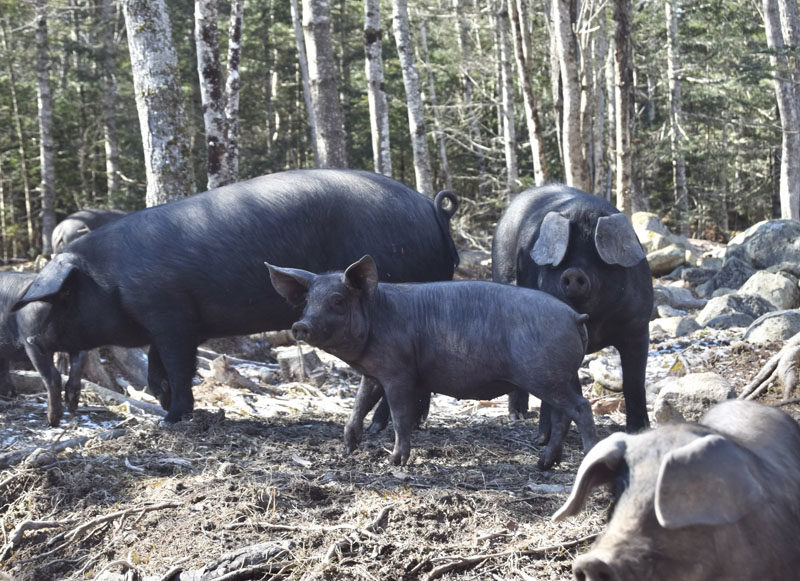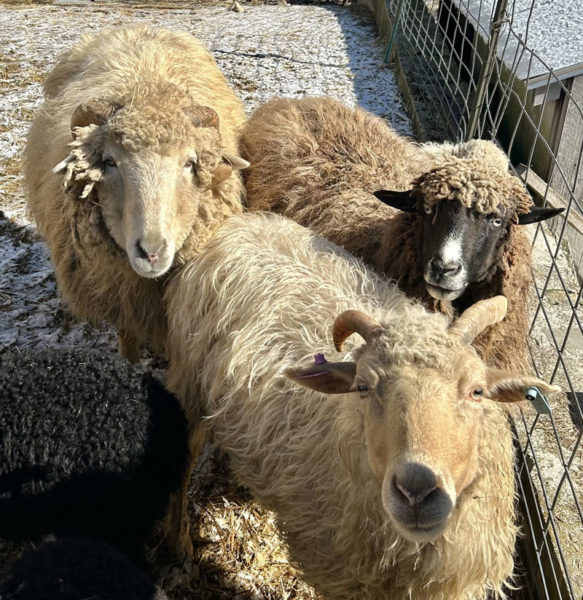
Torie DeLisle, co-owner of WoodHaus Farm in Waldoboro, feeds her flock of Navajo-Churro sheep on the morning of Feb. 29. Only about 4,000 Navajo-Churros are currently registered with the Navajo-Churro Sheep Association. Though low, that number is an improvement since the breed nearly disappeared before conservation efforts began during the late 19th century. (Molly Rains photo)
A number of rare livestock breeds that have nearly vanished elsewhere in the world are thriving in Waldoboro, thanks to the efforts of passionate local farmers.
Heritage breeds are, according to The Livestock Conservancy, traditional breeds of livestock that belong “to a bygone era.” The forefathers of modern agriculture raised these animals well before factory farming and mass-production became the norm, explained JoAnn Myers, of Beau Chemin Preservation Farm in southeast Waldoboro, on Feb. 29.
At Beau Chemin, Myers raises several varieties of heritage breeds, from fowl to several-hundred-pound donkeys. Small-scale farms like hers, Myers said, are in some ways the ideal location to host these animals and preserve their rare lineages. Likewise, many of these breeds are well-suited to meet the unique needs of Maine’s small-scale farms.
Myers attributed this to the versatility of heritage breeds, which she illustrated with the example of Icelandic cashmere dairy goats. The breed, which Myers raises at Beau Chemin using semen from Iceland in order to work around import restrictions, is extremely rare outside of its home country.
Like many heritage breeds, Myers said, these goats are desirable for their ability to produce a range of products, including dairy, meat, leather, and fiber for textiles and yarn.
Thus, with a heritage breed, “a small farmer, in one animal, has four to five different options,” Myers said. “That makes a lot of sense … If you are a small farm, which there are lots of in the Northeast, you need to be able to quickly pivot from one market to another.”
In addition to their versatility, heritage breeds’ long lineages are often bound up in human history. This is exemplified by Myers’ most recent addition to Beau Chemin: the rare Poitou donkey.
Originally developed in France to breed prized Poitou mules, the Poitou donkey saw its numbers decline rapidly after World War II, when draft animals were increasingly replaced with machines. The Nazi occupation of France also played a role in the animals’ disappearance, Myers noted, as many Poitou were converted into rations by starving citizens during that time. By 1977, there were as few as 12 stallions remaining.
A push to recover the breed has seen some success. In 2020, The Livestock Conservancy estimated that there were about 70 purebred Poitou in the United States and somewhere around 500 globally. Three more can now be found in Waldoboro, under Myers’ care.
Elsewhere in Waldoboro, other rare heritage breeds are thriving. A herd of about 20 endangered Navajo-Churro sheep munch on local hay at WoodHaus Farm on Duckpuddle Road, where owners August and Torie DeLisle have embraced the responsibility of raising a heritage breed since a Craigslist ad led them to acquire their first breeding pair.
Like other heritage breeds, Navajo-Churros are versatile. Compared to industrial breeds of sheep, which are typically bred to produce either meat or fiber, Navajo-Churros sit somewhere in the middle of those two uses and produce both meat and wool, Torie DeLisle said at WoodHaus on Feb. 29.
Neither product, however, is as refined as the sheep products consumers recognize today, which come mostly from animals bred specifically for one purpose or the other. For this reason, Navajo-Churros are sometimes disparaged as “unimproved,” August DeLisle said.
As large-scale farming has developed, he said, “the wool industry went in a different direction, the meat industry has gone in a different direction, and Churros are just left behind.”
Another factor in the dwindling of the Churros’ population, which according to the Navajo Sheep Project reached a low of about 450 individuals by the early 1970s, is – as with the Poitou – tied closely to human history.
Navajo-Churro sheep are so named for their importance and historic ties to Indigenous Americans of the Southwest, including, especially, the Navajo Nation. Though the sheep were originally brought to the Americas by Spanish colonists, they became important both culturally and economically to the Navajo as early as the 1600s.
U.S. government campaigns against the Navajo people involved measures against their livestock, drastically reducing the number of living Navajo-Churro sheep. This included the forced internment of Navajo people at a camp called Bosque Redondo in 1865, to which about 9,000 Navajo people and their animals were forced to walk about 300 miles.
Many people and their animals perished during the journey. For those who survived, Navajo-Churro sheep became a vital lifeline within the camp, according to the archives of the National Museum of the American Indian.
In the 1930s, the Navajo-Churro population was further reduced by U.S. settlers when a “stock reduction” of Navajo peoples’ sheep, goats, horses, and cattle was forcibly undertaken by the government. The Navajo-Churro Sheep Association estimates today that about one-third of each household’s livestock were slaughtered and either burnt or left to decompose during that time.
One reason given for the attempted extermination, according to the Navajo Sheep Project, was the so-called “unimproved” nature of the coarse-wool sheep.
However, what is clear to Navajo farmers and others who, today, are helping to strengthen the extant population of Navajo-Churro sheep – including the DeLisles – is that the qualities some may call “unimproved” can, in the right context, be seen as assets. At WoodHaus, the DeLisles noted that their flock is remarkably hardy, with their thick, layered coats allowing them to withstand Maine winters without a shudder. The sheep are generally quite healthy, Torie DeLisle said, and lamb easily.
The DeLisles primarily raise their flock as meat animals, but they also shear and save the animals’ wool and are hoping to find someone interested in putting the fiber to use.

Harriet, a juvenile Large Black pig, forages with her relatives beneath a canopy of oak trees at Greener Days Farm in Waldoboro. Large Black pigs are today one of the rarest British pig breeds, and Large Blacks with ears like Harriet’s are even rarer, making up less than 1% of individuals, said Laura Martel, farm co-owner. (Molly Rains photo)
Versatility, hardiness, and good health are just some of the reasons why it’s important to continue the fight to conserve heritage breeds, Myers said. As agriculture has shifted away from small mixed-use farms, she said, many heritage breeds have gone the way of the Poitou and Navajo-Churro, their populations dwindling to record lows.
However, conserving heritage breeds can benefit not just the small-scale farmers who introduce the animals to their own farms but the field of agriculture as a whole, Myers said. Allowing such breeds to die out, she said, would be a loss the extent of which is not known.
“When you throw away genetics through the development of industrial breeds, you don’t know what you’ve cast away,” she said.
This includes the traits that obviously differentiate heritage breeds from their mainstream counterparts, like the multicolored wool of Navajo-Churros or the unique shape of the Dutch hookbill ducks that Myers also raises at Beau Chemin.
It can also include traits that are hidden yet vitally important – for example, disease resistance, a trait that will become increasingly important, as according to the World Health Organization livestock disease is on the rise.
Genetic diversity is essential to breeding animals that are disease-resistant and viable in the long-term, Myers said. With the Icelandic cashmere dairy goats of Beau Chemin, Myers said, she hopes that her herd could serve as a genetic reservoir for the breed in case disease or another disaster befalls the goats in their native land.
As a relatively small farm, she added, serving such a niche purpose is the most meaningful way she felt able to contribute to global agriculture.
Myers said she originally decided to raise heritage breeds after realizing that working with highly endangered breeds would maximize her impact.
For animals whose populations have dwindled dangerously close to disappearance, she said, even raising just a few animals can make a significant difference for the breed as a whole. In this way, she said, even small farms with only a few animals can “still be useful.”
Viewed through this lens, the small farms in Waldoboro where heritage breeds are thriving are making a sizable contribution to worldwide efforts to keep rare lineages afloat.
This includes more than Beau Chemin and WoodHaus. Heritage breeds of fowl produce a rainbow of eggs at Quarryside Farm near Quarry Hill, while at Greener Days Farm on Miller Road, farmers Craig and Laura Martel steward a herd of about 70 critically endangered Large Black pigs that is the largest in the country – and possibly, said Laura Martel on March 1, the largest in the world.
Like many other heritage breeds, the Large Black was once prized but declined concurrently with the rise of intensive factory farming, as the breed thrives only when raised outdoors. At Greener Days, the animals flourish on a diet of Waldoboro acorns and other forage.
Myers, the DeLisles, and the Martels all said that one notable feature of their heritage breed livestock was their friendly demeanor.
“They’re easy-going, like big dogs,” Craig Martel said of his pigs, which weigh upward of 500 pounds as adults. “Some of them like belly rubs,” he said.
The friendly nature of the Poitou, said Myers, was reason in itself to conserve the breed.
“There’s something that’s very rewarding for humans to have interaction with an animal that’s friendly and warm and welcoming,” she said.

Navajo-Churro sheep gaze into the camera at WoodHaus Farm in Waldoboro. The rare sheep breed is known for its range of colors, which for each sheep tend to change over the course of their life. (Molly Rains photo)
Of WoodHaus’ Navajo-Churros, “they’re very friendly, which is probably why we keep them,” Torie DeLisle said. “And I like that we’re, however small, helping a critically endangered breed,” she added.
When it comes to young farmers taking the leap to begin raising heritage animals, “I really have to give them accolades for making that effort and making that decision,” Myers said.
In the future, she said, more small-scale farmers could raise heritage breeds to lend their operations more flexibility while contributing to a project much broader than their own farms.
After all, she said, the work is not just gratifying for its scientific and agricultural benefit. It’s also, she said, “just really fun.”
For more information about Beau Chemin Preservation Farm, go to beaucheminpreservationfarm.com; about WoodHaus Farm, go to woodhausfarm.com; about Greener Days Farm, go to greenerdaysfarm.com; and for more information about Quarryside Farm, find them on Facebook.



